Sushi for Beginners: Liven Up Your Food Delivery Order (and Just Say No to California Rolls)
Posted by Sara on Thursday, April 24th, 2014 with 7 Comments
Sushi day in the office can be amazing: gathering around a table full of healthy, fresh, flavorful sushi with your coworkers, tasting and trying a wide array of dishes. Or, it can be miserable, particularly if you don’t know much about sushi or its seemingly complicated etiquette. If you’ve learned to add the familiar, yet bland “California roll” to the food delivery order and retreat to your desk with a clandestine fork, well, no wonder you don’t like sushi day.
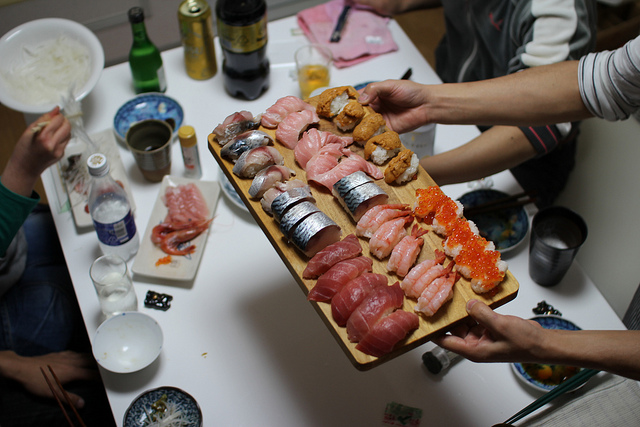
The fun of eating sushi is trying different kinds of fish and ingredients.
Image source: Flickr user daiki_moriyama
But despite the intimidating vocabulary of a sushi menu, and what can seem like a mysterious web of etiquette to the uninitiated, sushi is actually very straightforward. The point of the cuisine is its simplicity: high-quality, perfectly seasoned rice, the freshest fish, and just a few garnishes. And if you’re not used to eating raw fish, no problem. There are alternatives, and an easy path to slowly getting comfortable with the idea (and it’s a delicious one).
So here’s our breakdown of sushi for beginners: all the basics you need to know to navigate this food delivery staple like a pro. You just may never order another California roll again.
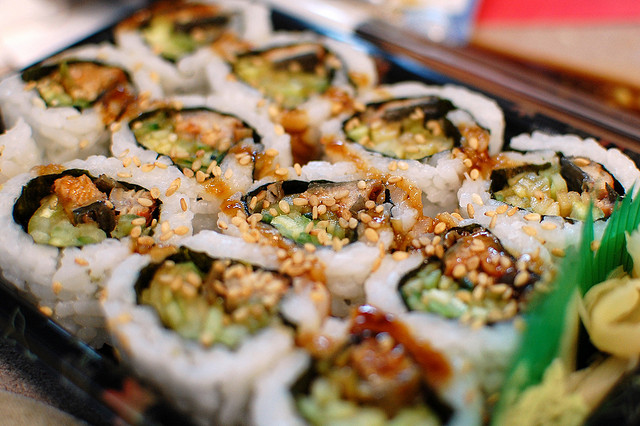
This is an eel (unagi) roll, with its signature sweet, sticky sauce.
Image source: Flickr user Mark H. Anbinder
Let’s start with rolls — the most familiar form of sushi for most Americans, and called maki in Japanese. Maki usually consist of a filling (fish, vegetables, or a combination of the two) and sushi rice, all rolled up in dried seaweed (called nori) and then cut into six to eight pieces. Sometimes the rolls are “inside out” — with rice on the outside, nori in the middle, and the fish and/or veggies still in the heart of the roll — and these are called uramaki. You might also see temaki, which is essentially a big cone of dried seaweed filled with rice, fish, and/or vegetables.
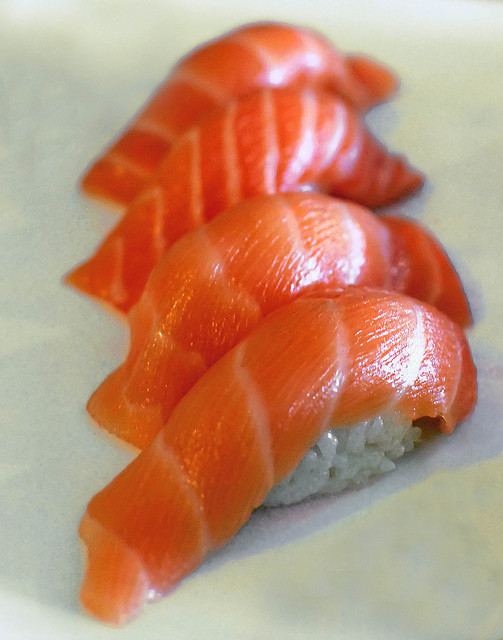
Nigiri is fish atop rice, usually with a little wasabi in between.
Image source: Flickr user Matthew Mendoza
If you’re still uneasy about raw fish, get used to rolls before diving into the delicious world of nigiri. Here, a little mound of sushi rice is crowned with a slice of fish, usually with a dab of wasabi in between. Proper sushi etiquette calls for nigiri to be eaten by hand, and the fish side only to be dipped into soy sauce (the rice should be kept just as the chef prepared it).
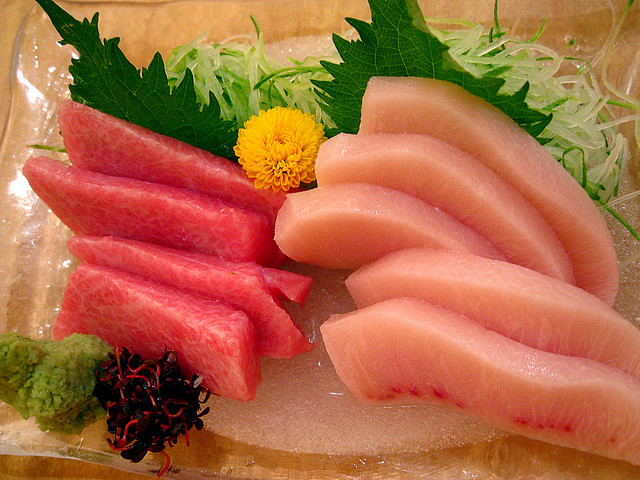
Sashimi is sushi sans rice: simple, thinly sliced pieces of fresh fish.
Image source: Flickr user Sanctu
Sashimi is the rare sushi dish that doesn’t include rice. Simple and straightforward, sashimi is thin slices of raw fish eaten with chopsticks. If you do like raw fish, this is the absolute best way to fully experience the often creamy texture and clear flavors of high-quality tuna, salmon, and other kinds of fish.
Chirashi is essentially sushi salad. Sushi rice, topped with sashimi and vegetables, in a decent-sized bowl — oftentimes, this is a wonderful way to try a few different kinds of fish, while being able to build your own bite if you don’t necessarily want a mouthful of straight fish.
Those are the basic types of sushi you’ll encounter on most menus. Start out with more familiar ingredients, like spicy tuna rolls, salmon nigiri, or sashimi. If you’re still wary about raw fish, most of the time eel (called unagi) and shrimp (called ebi) will be cooked, so look for rolls containing those. Specialty rolls (items like rainbow rolls, dragon rolls, etc.) are usually topped with slices of raw fish, like nigiri. And if you want to avoid overly Americanized sushi, steer clear of anything with cream cheese (sorry, Philadelphia roll!).
Now, for the etiquette:
Sushi has three traditional “sides” or condiments: soy sauce, wasabi, and pickled ginger. Beware if you haven’t tasted wasabi (Japanese horseradish) before: it’s quite potent, and a little dab goes a long way (and you may not need any extra wasabi at all). Pickled ginger is served as a palate cleanser between bites, so refrain from putting a slice on top of your sushi before you eat it. As for soy sauce, pour a little in a dish for dipping. Try to avoid soaking the rice directly in the sauce (which will make it fall apart), or drowning your delicate sushi flavors — just a little dip on the fish side is usually best.
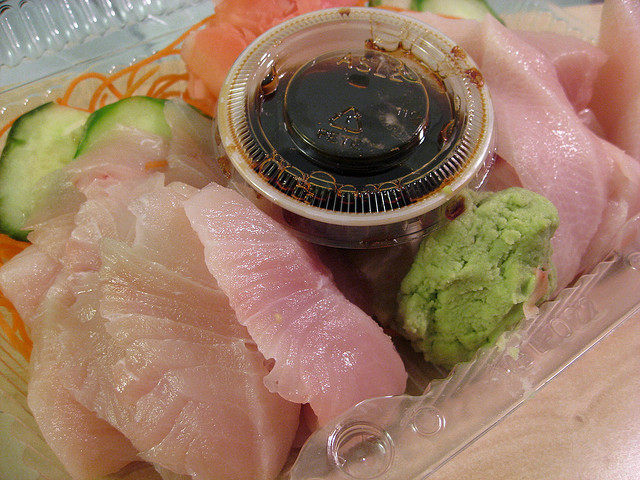
Go easy on the soy sauce and wasabi, and eat the ginger between bites of sushi.
Image source: Flickr user Renee Suen
You might see some sushi lovers mix their wasabi right into their soy sauce, rather than dabbing a little bit on each piece. There’s some debate about whether this is an appropriate tradition or counts as an insult (yes, those are two contradictory verdicts from the same respectable publication), but generally, don’t use this practice when you’re eating nigiri — the thought is, the chef has already put the perfect dab of wasabi between the fish and the rice, so any more is unnecessary. On the other hand, it’s perfectly acceptable to mix wasabi into soy sauce while you eat sashimi.
If you fear chopsticks, don’t worry: maki and nigiri are both meant to be eaten by hand. Only sashimi requires chopsticks. While this is traditional etiquette, it isn’t always widely practiced, but if you see a raised eyebrow from a colleague explain that sushi rice shouldn’t be pinched or it loses its delicate form (this is also a good rule of thumb: eat sushi containing formed rice by hand, sushi without rice by chopstick).
Don’t feel bad about opening your mouth as wide as you can: most sushi is meant to be eaten in one bite. Do feel bad about rubbing your chopsticks together before you eat, like you’re trying to start a fire — this implies you think the chopsticks are unsafe or made poorly, which is rarely the case and will make you look pretty rude if you do it at an actual sushi bar or restaurant.
In the end, sushi is one of the most social meals you can enjoy with your coworkers, so make it an interactive occasion! And whether you grow to love ordering an array of delicate nigiri or simply find a new favorite roll, the food delivery experts at Waiter.com can help ensure it’s easy to order, delivered promptly, and just the healthy, fresh lunch you need during a busy day at the office.
When it comes to feeding employees and coworkers, make your company's food program really count! If your workplace dining plan needs to take it up a notch — or if you don't have one at all — Waiter.com is here to help. From Virtual Cafeteria Service to diverse menus to local takeout & delivery, Waiter.com offers customizable dining solutions for every business and budget. Contact us today to get started!
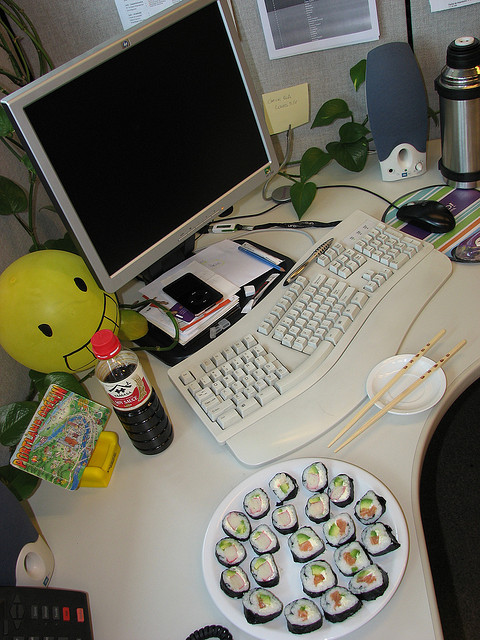

This article touched on many points of sushi etiquette that many novice sushi eaters don’t realize. For instance, the ginger is not meant as a topper! The author was correct in stating that the ginger is for palette cleansing. Also, the descriptions of each type of sushi that the authors gave were spot on! What type of fish is typically used for sashimi? Overall, great article and great descriptions of each type of sushi!
I have always found sushi to be such a fascinating food. Not only is it just a food, it’s really an integral part of Japanese culture, and it’s full of tradition. I’ll admit I do cringe when my husband mixes his wasabi into his soy sauce (I’m a bit of a sushi snob) beause I did read somewhere that this isn’t proper etiquette. Although in his defense, we are in The good ole’ US so it really doesn’t matter.
This is a great article. I have a hard time trying new foods (especially fish!) and I get intimidated when others around me suggest more ethnic cuisine because I truly feel ignorant about how to eat it. I have passed on several work lunches as a result! I think I will give maki a try as it can be made with just vegetables, which seems like a non-intimidating way to get started down the path of sushi. Even if I don’t like it I’ll know enough to not rub my chopsticks together! 🙂
This is one of the best articles I have ever read about Sushi. I love sushi and I love to know and try different types of sushi. I was wondering to make sushi at home. I hope my sushi will taste good and kids will like it. Thanks for sharing such an amazing article.
Thank you for reading!
(Cooked) shrimp nigiri was my “gateway” sushi. The taste of seeweed on rolls was a bit of a turnoff, but the lack of anything but rice and a piece of seafood I eat a lot anyway made for a good combo. Later I branched out, still mainly nigiri (salmon is the fave, also tuna is pretty high on my list, sometimes even sample roll now and then) but I love it.
We love sushi also!